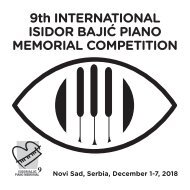10th Isidor Bajic Piamo Memorial Catalogue
Find out the competitors and their competition program of the 10th edition of Isidor Bajic Piano Memorial, international piano competition in Novi Sad, Serbia.
Find out the competitors and their competition program of the 10th edition of Isidor Bajic Piano Memorial, international piano competition in Novi Sad, Serbia.
Create successful ePaper yourself
Turn your PDF publications into a flip-book with our unique Google optimized e-Paper software.
ISIDOR BAJIĆ (1878 - 1915)<br />
<strong>Isidor</strong> Bajić was born on August 16, 1878 in<br />
Kula, a small town in Bačka, not far from<br />
Novi Sad. His name is associated with the image<br />
of a versatile music artist who left a significant<br />
mark through his engagements as a<br />
composer, pedagogue, writer, and organizer<br />
in the cultural life of Vojvodina at the turn of<br />
the 20th century. Bajić became interested<br />
in music in his early high school days. A testimony<br />
to this is his then still boyish interest<br />
in music lessons. Nevertheless, his studentdedication<br />
led him to take part in “music<br />
jobs” together with his teacher Jovan Grčić,<br />
which determined his future vocation to a<br />
significant extent. While in the sixth grade,<br />
Bajić began to compose, and in the eighth<br />
he conducted the student choir. Following<br />
his father’s desire, he enrolled in law studies<br />
in Budapest after completing grammar<br />
school, and shortly afterwards embarked on<br />
his musical studies at the Music Academy. It<br />
is known that the young composer was in-<br />
terested in the social life of the Serbian community<br />
at that time, forming the Serbian Students’<br />
Choir, for which he organized numerous<br />
performance opportunities, also leading<br />
the choir as a conductor. Upon completing<br />
his studies, <strong>Isidor</strong> Bajić moved back to Novi<br />
Sad where he was appointed a teacher of<br />
singing and church singing at the High Serbian<br />
Orthodox Lyceum (today known as High<br />
School Jovan Jovanović Zmaj). Simultaneously,<br />
he gave piano, violin, and tamburitza<br />
lessons, formed the string and tamburitza<br />
orchestra, and led the Lyceum choir. In addition<br />
to his pedagogical work, Bajić had a<br />
prominent role in the shaping of the music<br />
awareness of the time. In publications and<br />
daily newspapers (Branko’s Ring, Chronicle<br />
of Matica Srpska), he regularly published<br />
texts on music, at the same time establishing<br />
the only music magazine inYugoslavia of<br />
the times, Serbian Music Magazine, as well<br />
as an edition of printed music, Serbian Music<br />
Library, which focused on publishing works<br />
by <strong>Isidor</strong> Bajić and his contemporaries. Bajić<br />
expanded the limited methodological literature<br />
by authoring two textbooks: Piano and<br />
Piano Teaching (1901) and Theory of Correct<br />
Singing from Notes (1904). <strong>Isidor</strong> Bajić also<br />
acted as a melographer, as a result of which<br />
many of the folk and church melodies he collected<br />
were then used in his composing of piano,<br />
orchestral, and choral works. In addition<br />
2



